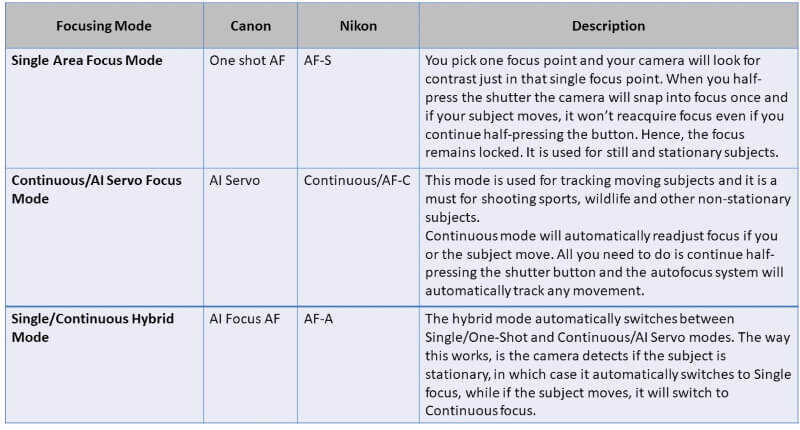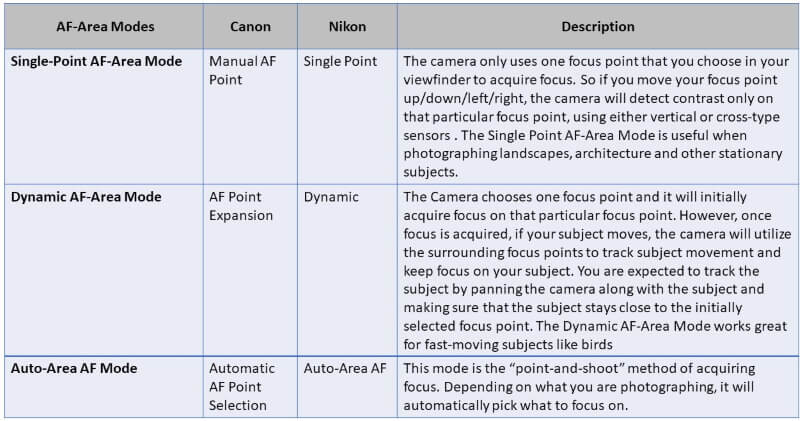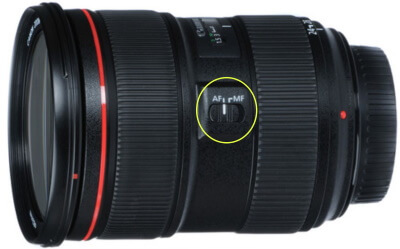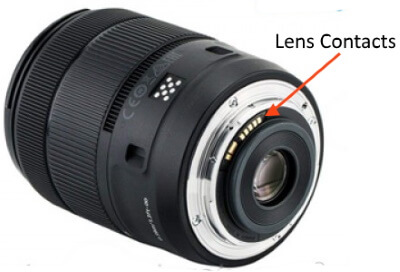When your DSLR lens would not focus properly, and instead, it would constantly move in and out (hunting for focus), not stopping to focus on any particular object. Autofocus doesn’t always work perfectly. It can pick up the wrong thing or fail to find anything to focus on and you get blurry photos. It is surely an autofocus issue.
In this post, I’ve gathered some possible causes for having focusing problems with your camera and lenses. I do believe that knowing your autofocus system well, and how it actually works will help you a lot in solving most of your autofocus problems. Let us begin by summarizing the types of autofocus systems and their modes.

Summary of the autofocus system
Autofocusing types
There are two types of AF (Autofocus) systems: Active and Passive.
The Active AF system works by shooting a red beam on your subject, then bouncing that light back to your camera to figure out the distance between the camera and the subject. Once the camera knows what that distance is, it instructs the lens to adjust focus based on this information. The pros of active AF is that it can be used in very poorly lit environments, where normal (passive) AF does not function. The cons of Active AF is that it can be used only for stationary subjects and it only works for close subjects within 15-20 feet.
The Passive AF system works in two different ways:
- Phase Detection, It uses special sensors within the camera to detect contrast from the light that goes through the lens
- Contrast Detection, It uses the camera sensor itself to detect contrast in the image.

The term “detect contrast” means that the AF system tries to look for sharpness in a particular part of an image. If it is blurry, the AF system will adjust the lens focus until sharpness/contrast is achieved. When a lens starts to “hunt” for focus, it simply means that a camera cannot find enough contrast and sharpness to be able to acquire focus.
Focusing Modes
When photographing still subjects, you generally acquire focus once and take a picture. If the subject moves, you reacquire focus again and take another picture. However, if you have a subject that is continuously moving, you need your camera to readjust focus automatically as you take pictures. Modern DSLR cameras have a built-in system to handle such situations. The focus modes are summarized in the following table:

AF-Area Modes
The AF-Area Mode”, which allows photographers to choose several options to use while operating in Single Area/Continuous modes.

Common autofocus problems and how to fix them
-
The lens is not switched to Auto Focus

The most obvious and often overlooked cause is forgetting switching your lens to autofocus mode. The small switch on your lens lets you toggle between the two but often it’s easy to forget to switch back to autofocus.
-
The camera and lens need a tune-up
After using your camera for some time or just buying a new lens, you may find that your camera’s autofocus is not working well and you get blurry photos for no apparent reason. This might mean that your camera and certain lenses aren’t playing together nicely and it is time for a tune-up or a calibration. For more detailed information, you may check my post “How To Calibrate Your Lens- Enhance Autofocus Accuracy” and “How To Use Sigma USB Dock- Calibrate And Customize Your Sigma Lens”
-
Dirty lens contacts or camera contacts

The lenses are provided with metal contacts that connect with similar contacts in the camera body to establish communications ways between the lens and the camera. When the contacts get dirty, it can interfere with the focus system and create an error message.
The process of cleaning these contacts is easy. Use a bulb blower to remove dust, then use a swab and isopropyl alcohol or cleaning solution.
-
Dirty autofocus sensor
Sometimes the autofocus sensor is dirty, which, of course, leads to consistent focusing problems. To clean your AF focus, follow the steps below:
- Power on your camera.
- From your camera menu, choose “Lock mirror for cleaning”. The same way as you do when cleaning your camera sensor.
- Use a bulb blower to shot some air into your AF sensor.
-
Selecting the wrong focusing mode
If you are not familiar with and understand the different types of focusing modes, you will easily get out-of-focus photos. So make sure you understand when to use each type of your focusing modes and focusing points and areas. Also, make sure you’ve selected the best autofocus area for your subject. Refer to your camera’s manual for an explanation of different autofocus area modes.
-
Check your camera diopter
Check your camera diopter when you are having trouble seeing clearly through your viewfinder. It is common to suspect that your lens has focus issues when dealing with this problem, however, the diopter is usually the culprit. The main function of the camera diopter is to allow any person to customize its vision through the viewfinder. Fine-tune the dial to represent a clear image in your viewfinder.
-
There are obstacles in front of your subject
If your subject is partially blocked behind an obstacle that you are unable to move out of the way or intend to keep, For example, if you are shooting a caged or penned animal, a person looking from a window or stood behind a gate, etc., this can easily foul the autofocus. You can solve this issue by zooming and carefully selecting suitable focusing points.

-
Taking shots when you are too Close to the Subject
One of the most common reasons for the DSLR camera’s autofocus to fail is that you are standing too close to the subject. It can be difficult for autofocus to achieve a sharp result when you are very close (unless you are using a macro lens). It depends on the type of your DSLR lens. All lenses dictate a specific ‘minimum focusing distance’ that tells you exactly how close in proximity you can be to your subject. The solution is quite easy, try to move farther back from the subject.
-
Low Light Makes for Tough Focusing Conditions
When shooting in low light, you may have autofocus problems. Even when your camera has an AF assist lamp built in. However, even if you have it switched on, it can only be used for stationary subjects and it only works for close subjects within 15-20 feet. Try holding down the shutter button halfway to allow the DSLR camera to have enough time to pre-focus on the subject when shooting in low light. You can also use an external flash to get the right focus.
-
Areas of Low Contrast
Looking for areas with high contrast will help you gain accurate focus. Cameras have the ability to track focus for higher contrasted areas in an image. For example, a cloudless blue sky or a wall that contains one solid color.
-
Direct Light That Causes Glare
Strong reflections can cause a DSLR’s autofocus to fail or to misread the subject. Wait for the reflection to diminish or change positions, so that the reflection is less prominent. You can also try using a hand to block out the light or a lens hood, and lock your focus.
-
Contrasted Patterns Can Fool Autofocus Systems
If you’re shooting a photo where the subject is wearing clothing with a highly contrasted pattern, such as light and dark stripes, or highly repetitive patterns like skyscraper windows or cars with reflective bodies the camera may struggle to properly autofocus on the subject. Again, you can try to pre-focus on the subject to fix this problem.
-
Shooting through glass
Avoid Taking photographs through glass with AF, for example taking photos through a plane window or fish in an aquarium. The AF system may home in on reflections, or marks on the glass. Try switching to manual focus.
the article is recapped in the below video
Related Posts
Manual Focus in Digital Camera- Manual Focusing Vs Autofocusing
What Is Autofocus And How It Work
How To Calibrate Your Lens- Enhance Autofocus Accuracy
How To Use Sigma USB Dock- Calibrate And Customize Your Sigma Lens
How To Clean Digital Camera Sensor
Thanks for reading, I hope you enjoyed the article if you have any questions just post below & I will be happy to answer you.
If you enjoy the site, don’t forget to subscribe, we will only inform you when a new article is posted.











Wow. this is something that one of my friends just complained to me about a few moments ago. He spoke about how he actually needs to fix his lens because it doesn’t hit the autofocus really well or something about balance in focus. I am not so sure if he makes use of the canon camera but this will be helpful however.
Thanks for this post. I also have this canon auto focus problem. The first time i bought it gave me a lot of issues but after a while it worked well, I couldn’t say this is exactly what I did & now it stopped working well. I tried everything I could, but it’s still not working fine as I want. I’m not trying to pay loads of money for someone just to check it out & find out i could have fixed it myself. Thanks for your guide on how to fix it.
Sorry to have troubles with your camera, I think if you follow the general guidelines mentioned in my article, you will solve the problem. If not I suggest that you try to calibrate your autofocus system. Don’t panic! the procedure is very easy. Check my post for detailed information. How To Calibrate Your Lens- Enhance Autofocus Accuracy, You can do it yourself